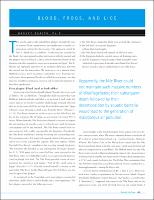Please use this identifier to cite or link to this item:
https://hdl.handle.net/20.500.12202/8927Full metadata record
| DC Field | Value | Language |
|---|---|---|
| dc.contributor.author | Babich, Harvey | |
| dc.date.accessioned | 2023-05-23T18:08:48Z | |
| dc.date.available | 2023-05-23T18:08:48Z | |
| dc.date.issued | 2008 | |
| dc.identifier.citation | Babich, H. (2007-2008). Blood, frogs, and lice. Derech HaTeva, 12, 63-67. | en_US |
| dc.identifier.uri | https://hdl.handle.net/20.500.12202/8927 | |
| dc.description | Scientific article | en_US |
| dc.description.abstract | This article analyses the initial three plagues through the eyes of various Torah commentaries and synthesizes scientific explanations within the discussions. The approach, noted by Rav E. Munk [1], is as follows: “In the miracles recorded in the Torah, the supernatural is often interwoven with the natural and the plagues may be defined as miraculously intensified forms of the diseases and other natural occurrences encountered in Egypt.” Rav E. Dessler [2] explained that there is no essential difference between the natural and the miraculous. We term an act as a miracle when HaShem causes a novel occurrence, unfamiliar to us. Everyday natural events, those governed by the so-called laws of nature, are also miracles, but their common occurrence and recognizable patterns dilute their significance. | en_US |
| dc.description.sponsorship | D E D I C A T I O N & A C K N O W L E D G E M E N T S The vision of Rachel Sussman, z”l, for the advancement of science at Stern College for Women was evident through her support of the state-of-the-art Sussman Biology Laboratory and Laboratory Preparation Room. It is our honor to dedicate this issue of Derech HaTeva in her memory. Rachel Sussman served as a role model for the women of Stern College and her numerous acts of philanthropy are shining examples of the many contributions one can make to enhance and better the lives of others. Her dedication to the development of areas relating to both Torah and science parallels the vision of this publication and it is only fitting that the twelfth edition of Derech HaTeva serves as a medium for her name to live on.¶ We would like to take this opportunity to thank the Office of the Dean and the Office of Admissions at Stern College for Women for their support of this journal. Specific thanks to Dean Karen Bacon whose vision for the students at Stern College for Women made this journal possible.¶ Our deepest appreciation and thanks to Dr. Harvey Babich for his unwavering dedication to this publication. From the initial topic selections to the final stages of layout, Dr. Babich was constantly available and helpful in all realms. We are extremely fortunate to have such a wonderful faculty advisor whose commitment to his students knows no bounds. | en_US |
| dc.language.iso | en_US | en_US |
| dc.publisher | Stern College for Women, Yeshiva University | en_US |
| dc.relation.ispartofseries | Derech HaTeva;vol. 12 ; 2007-2008 | |
| dc.rights | Attribution-NonCommercial-NoDerivs 3.0 United States | * |
| dc.rights.uri | http://creativecommons.org/licenses/by-nc-nd/3.0/us/ | * |
| dc.subject | plagues | en_US |
| dc.subject | blood | en_US |
| dc.subject | frogs | en_US |
| dc.subject | lice | en_US |
| dc.subject | supernatural v. natural | en_US |
| dc.subject | miracles | en_US |
| dc.subject | laws of nature | en_US |
| dc.title | Blood, frogs, and lice | en_US |
| dc.type | Article | en_US |
| local.yu.facultypage | https://www.yu.edu/faculty/pages/babich-harvey | en_US |
| Appears in Collections: | Stern College for Women -- Faculty Publications | |
Files in This Item:
| File | Description | Size | Format | |
|---|---|---|---|---|
| Babich Blood, frogs 63-67 DT 12 2007-2008.pdf | 120.23 kB | Adobe PDF |  View/Open |
This item is licensed under a Creative Commons License

